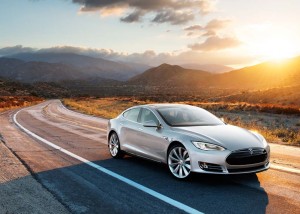At a time when other manufacturers have been struggling to gain traction in a slow-growing battery car market, California start-up Tesla Motors has been exceeding even its own optimistic expectations with the big Model S sedan.
Offering a nearly 300-mile range with its optional 85 kilowatt-hour battery – three times more than most electric models – is one factor that appears to be boosting sales. But now, Tesla hopes there’ll be another reason for buyers to plug into the Model S, the maker crowing that it has just received the best federal crash test results of any vehicle ever.
According to the National Highway Traffic Safety Administration, the Tesla Model S received an overall five-star rating, as well as five stars in every individual test category. That’s something that only 1% of the vehicles NHTSA has tested have so far received. But the battery sedan also set a new record for the lowest likelihood for passenger injury ever achieved in the government tests.
While NHTSA doesn’t publish results greater than those coveted five stars, Tesla claims that the battery sedan actually should have received 5.4 stars because it exceeded every benchmark in the government Vehicle Safety Score metrics.
In a release trumpeting the test results, Tesla suggested the Model S benefited from adopting a completely new vehicle architecture.
“The Model S has the advantage in the front of not having a large gasoline engine block, thus creating a much longer crumple zone to absorb a high speed impact,” Tesla explained. “This is fundamentally a force over distance problem – the longer the crumple zone, the more time there is to slow down occupants at g loads that do not cause injuries. Just like jumping into a pool of water from a tall height, it is better to have the pool be deep and not contain rocks.”
Tesla notes that it “is possible” to “game” the testing process by bracing a vehicle in precisely the spots which would take the brunt of the impact in a crash test. But it insists that its own goal was to find weaknesses during internal development and improve the overall crashworthiness of the sedan. The maker pointed to one particular example.
“Of note, during validation of Model S roof crush protection at an independent commercial facility, the testing machine failed at just above 4 g’s,” it wrote. “While the exact number is uncertain due to Model S breaking the testing machine, what this means is that at least four additional fully loaded Model S vehicles could be placed on top of an owner’s car without the roof caving in.”
(Click Here to read about Tesla’s plans to double Model S production.)
The NHTSA results are just the latest endorsement the battery-car has received. It was voted Car of the Year by Motor Trend magazine and earned the highest overall assessment ever from influential Consumer Reports magazine.
Those third-party raves have helped Tesla surge in sales in recent months, well exceeding its own expectations and boosting earnings for the first half of the year. In fact, it landed in the black for the second quarter, confounding the loss forecasts from most industry analysts.
(Investors flock to Tesla after another positive earnings report. For more, Click Here.)
That, in turn, has led to a roughly fourfold increase in Tesla stock since the beginning of the year, shares closing Monday at $144.90 on the New York Stock Exchange.


So basically a Tesla is about the same as a 5-star pick-up. 😉
What’s Toyota’s role in Tesla nowadays? Do they supply technology or acquire it? What vehicles previously belonged to the same 1% crash categories?
Hi, Fantabulous,
Sorry I can’t give you an immediate answer on the 1%. We’ll try to get clarification from NHTSA. As for Toyota and Tesla, the Japanese had invested cash into the US start-up a couple years back, a time when Tesla desperately needed help, and Toyota provided the abandoned NUMMI plant where the Model S is now built and where the Model X (and likely other battery-cars) will be added. Tesla, in turn, has provided the electric drive system for the Toyota RAV4 EV and was expected to work with Toyota on at least one other battery-car program. There have been some tech swaps here but I am not 100% sure I have the latest to add to that.
Interestingly, CEO Elon Musk noted last year that it was Tesla’s relationship with Daimler AG that actually helped prop up the start-up when it was most financially strained. Tesla has and is continuing to work with Daimler on various vehicle programs.
Paul A. Eisenstein
Publisher, TheDetroitBureau.com